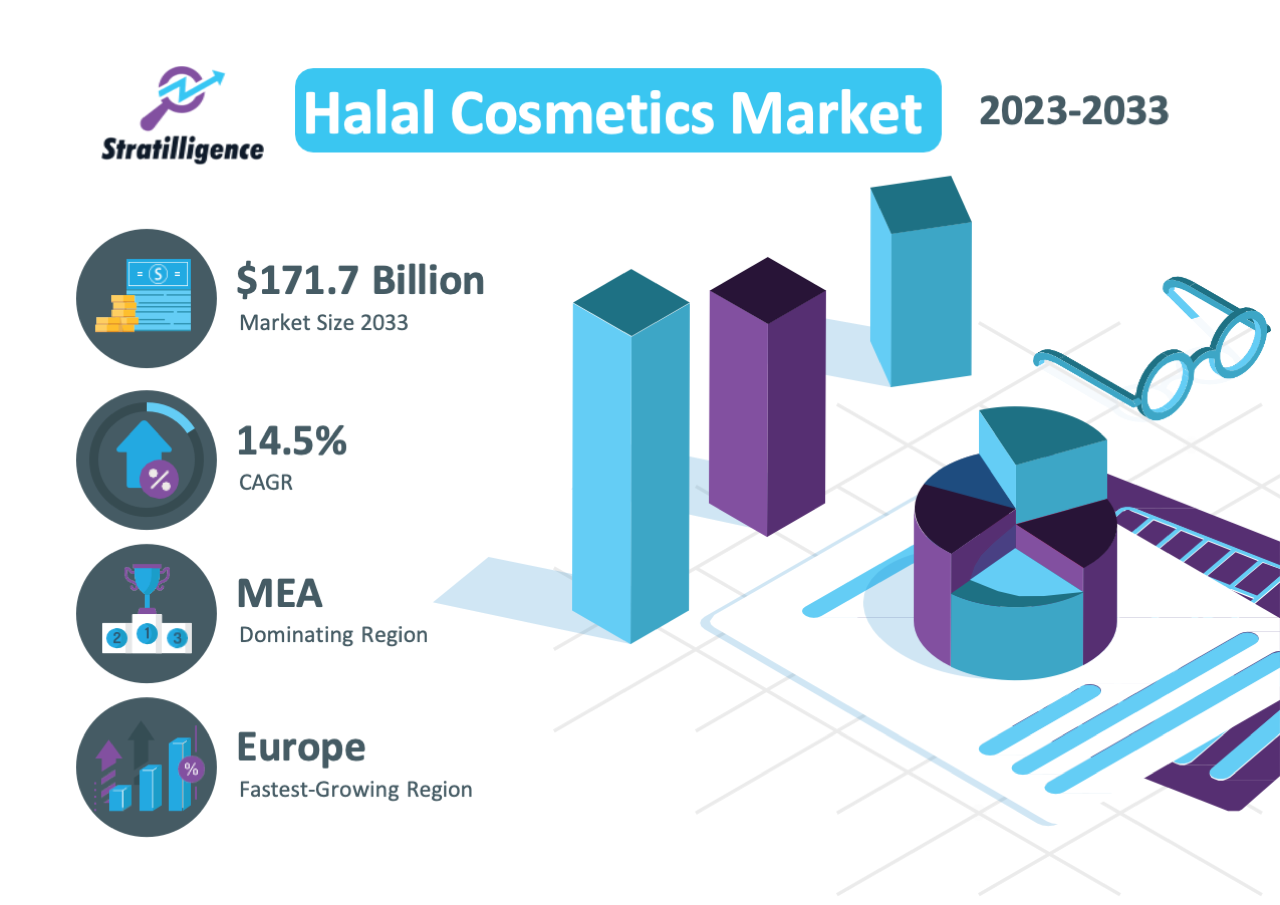Follow Us :
Halal Cosmetics Market Report: Size, Share, Trends, and Forecast (2024-2033) – By Product Type, Application, and Distribution Channel
- Report ID: STAR2224
- Industry: Consumer & Retail Goods & Services
- Published Date: 07-10-2024
- NUMBER OF PAGES: 225
- FORMAT:
Halal Cosmetics Market Research: 2033
The global halal cosmetics market was valued at $44.7 billion in 2023 and is projected to reach $171.7 billion by 2033, growing at a CAGR of 14.5% from 2024 to 2033. Halal cosmetics are made, produced, and contain permitted components based on Islamic law. This means that the constituents used to manufacture these cosmetics are not animal-derived or tested on animals, do not involve alcohol, and have nothing that is unlawful in Islam. Moreover, it must follow Islamic rules like ethical sourcing and fair labor practices during the production process. Halal cosmetics are designed for Muslim buyers who want to use products consistent with their religious convictions and morals.

Both Muslim and non-Muslim buyers are becoming increasingly aware of what goes into their cosmetics and the ethical aspects entailed in their production. This makes requests for Halal cosmetics soar up. The number of Muslims around the world is constantly growing so there is now a larger demand for other Islamic-compliant products including these cosmetics. Committed Muslims consider it significant to conform even about things like personal care products, such as make-up, to Islamic principles hence they require halal-certified ones. Most people think that Halal cosmetics have been extracted responsibly and not tested on animals which has attracted greater appeal from other consumers who hold the same virtues besides being Christians for instance.
Key Market Drivers and Growth Factors in the Halal Cosmetics Market
Several countries with substantial Muslim populations have introduced rules and regulations for Halal products, thereby creating an enabling environment for the growth and development of the industry. The use of halal cosmetics does not only revolve around Muslim-dominated states. However, these are now found in many mainstream markets targeting all sorts of customers that require religiously correct and ethically permissible items. Thus, to satisfy the rising requirement for Halal cosmetics, there is a need to develop innovative formulations, packaging materials as well as marketing techniques that will suit consumers’ specific desires and wants.
The upward push of Halal tourism has also contributed to the boom of the Halal cosmetics industry. Tourists from Muslim-majority international locations are searching for Halal-certified products for the duration of their travels, prompting outlets and producers to cater to this call.
Challenges and Restraints in the Halal Cosmetics Market
Despite developing awareness, many clients, specifically in non-Muslim-majority regions, may not virtually apprehend the concept of Halal cosmetics or the benefits they offer. This can restrict name for and market penetration. Adhering to Halal requirements frequently requires extra certifications, sourcing practices, and production techniques, that could grow manufacturing expenses. This may additionally moreover bring about higher fees for Halal cosmetics compared to conventional alternatives, likely limiting affordability for a few purchasers.
Obtaining Halal certification may be a complex and time-ingesting approach, regarding rigorous inspections and compliance with particular requirements. This may act as a barrier for smaller groups or startups coming into the Halal cosmetics marketplace. The loss of standardized policies and certification techniques for Halal cosmetics all through special regions and countries can create traumatic conditions for producers and exporters, major to inconsistencies and complexities inside the market.
Technological Innovations in the Halal Cosmetics Market
The Halal cosmetics industry can increase its attain beyond Muslim-majority countries and areas of interest markets. Targeting non-Muslim customers who prioritize ethical and sustainable merchandise can open up new growth opportunities. Continued innovation in formula, packaging, and advertising will power growth in the Halal cosmetics market. This includes the improvement of the latest substances and technologies to create exquisite, effective merchandise that meets Halal requirements. With the increasing occurrence of e-commerce structures and virtual advertising channels, Halal cosmetics manufacturers can reach a much broader target audience and interact directly with consumers. This allows for personalized advertising techniques and targeted messaging to exceptional demographic businesses.
Regulatory Landscape in the Halal Cosmetics Market
Governments and regulatory bodies in Muslim-majority nations are more and more spotting the significance of Halal certification for cosmetics. Standardizing certification approaches and guidelines can streamline the market get entry to and facilitate global alternatives. Growing cognizance of fitness and well-being amongst consumers international presents possibilities for Halal cosmetics brands to put themselves as natural, organic, and clean splendor alternatives. Formulating merchandise with herbal and organic ingredients that comply with Halal standards can attract fitness-aware clients. Collaborating with other industries, together with food and pharmaceuticals, can create synergies and possibilities for innovation in Halal cosmetics.
For example, leveraging know-how in Halal substances utilized in meal production for cosmetics formulations. Continued schooling and advocacy efforts are critical for elevating consciousness approximately the blessings of Halal cosmetics and dispelling misconceptions. Building agreement with and credibility with clients through obvious communique about sourcing, manufacturing, and certification tactics may be key to long-time period achievement.
Collaborating with other industries, together with food and pharmaceuticals, can create synergies and possibilities for innovation in Halal cosmetics. For example, leveraging know-how in Halal substances utilized in meal production for cosmetics formulations. Continued schooling and advocacy efforts are critical for elevating consciousness approximately the blessings of Halal cosmetics and dispelling misconceptions. Building agrees with and credibility with clients through obvious communique about sourcing, manufacturing, and certification tactics may be key to long-term achievement.
Coverage of the report
| Scope | Details |
|---|---|
| Market Size Estimation | Quantitative Insights: Market size and projections from 2019 to 2033, Market Size Units: USD Million |
| Market Dynamics | Analysis of drivers, restraints, and trends shaping the market |
| Industry Analysis | Value chain analysis, Profit margin analysis, and Industry Overview |
| Segmentation | Product Type (Personal Care Products, Color Cosmetics, Fragrances), by Application (Hair Care, Skin Care, Face Care, Beauty Care), by Distribution Channel (Offline, Online) |
| Region Insights | Detailed analysis for North America, Europe, Asia-Pacific, Latin America, MEA with key countries in each region |
| Competitive Analysis | Company profiles, Ranking/Market share analysis, Competitive structure, Product differentiation |
| Customer Landscape Analysis | In-depth understanding of customer industry, preferences, and buying patterns |
| Supplier Analysis | Comprehensive analysis of suppliers |
Key Benefits for Stakeholders
This comprehensive report provides stakeholders with in-depth qualitative and quantitative analyses, focusing on the global halal cosmetics market from 2023 to 2033.
Key benefits include:
- Insightful Market Forecast: The report offers detailed projections, covering various segments, current trends, and market dynamics.
- Competitive Analysis with Porter’s Five Forces: A thorough examination of the bargaining power of buyers and suppliers, the threat of new entrants, competitive rivalry, and substitute products.
- Comprehensive Market Overview: Gain access to crucial information about key market drivers, restraints, and opportunities.
- Regional and Country-Level Mapping: The report maps out major regions and countries based on their revenue contribution to the global halal cosmetics market.
- Market Player Positioning: The competitive landscape analysis provides a clear understanding of the current market positioning of key players.
Halal Cosmetics Market Segmentation
The global halal cosmetics market is segmented on the basis of product type, application, distribution channel, and geography. Based on product type, the market is segmented into personal care products, color cosmetics, and fragrances. Based on application, the market is segmented into hair care, skin care, face care, and beauty care.
Regional Analysis of the Global Halal Cosmetics Market
Region-wise, the halal cosmetics market analysis is conducted across North America (the U.S. and Canada), Europe (UK, France, Germany, Italy, and Rest of Europe), Asia-Pacific (China, Japan, India, South Korea, and Rest of Asia-Pacific), Latin America (Brazil, Mexico, Argentina, and Rest of Latin America), and MEA (Saudi Arabia, UAE, Kenya, South Africa, and Rest of Middle East & Africa).
The North American and European locations have an enormous Muslim population, which has been growing regularly. As Muslims emerge as greater affluent and included in North American and European society, there’s a growing call for for Halal-licensed products, which includes cosmetics. North America and Europe have visible a surge in hobbies in ethical and smooth beauty merchandise amongst consumers concerned about animal welfare, sustainability, and aspect transparency.
Halal cosmetics, with their emphasis on cruelty-free, ethically sourced, and herbal ingredients, align well with these traits. Halal cosmetics manufacturers have been a success in penetrating mainstream retail channels within North America and Europe, along with uniqueness shops, online structures, and even predominant shops. This increased availability has made Halal cosmetics more on hand to a broader consumer base.
Competition Analysis
The major players profiled in the report having significant halal cosmetics market are Amara Cosmetics, Iba Halal Care, Halal Cosmetics Company, Clara International, Inika, Wardah Cosmetics, PHB Ethical Beauty, Sampure Minerals, One Pure, Mena Cosmetics, and SaafSkinCare.
Key Developments/ Strategies in Halal Cosmetics Market
Major companies in the halal cosmetics market have adopted product launch, partnership, business expansion, and acquisition as their key developmental strategies to offer better products and services to customers in the market which is contributing to halal cosmetics market growth.
- In April 2023, India based Trove & Trendy launched gel polish. It is formulated to be water-permeable allowing water to pass through the polish and reach the nails.
- In November 2023, Indonesia based ESQA Cosmetics raised US$6 million for expansion of its presence, conduct research on products, and strengthen its skincare products category.
- In January 2023, U.S based Flora & Noor launched seven of the brand’s products: Rose Renewal Cleanser, Rose Renewal Tri-Peptide and Ceramide Moisturizer, Berry Oxygen Mask, Boost and Brighten Vitamin C Cleanser, Vitamin C Resurfacing Toner, Bright Side Serum, and Super Glow Gel Moisturizer.
To explore the complete range of topics and critical insights our report offers, including comprehensive chapter names and pivotal sections, we invite you to submit a request for a detailed sample. Your inquiry will unlock an in-depth perspective on the report’s valuable content.
Chapter 1: Executive Summary
-
- Overview of the report
- Key findings and insights
- Market Entry Strategy (Add-on)
- Strategic Recommendation
Chapter 2: Introduction
Chapter 3: Market Overview
Chapter 4: Halal Cosmetics Market, by Product Type
Chapter 5: Halal Cosmetics Market, by Application
Chapter 6: Halal Cosmetics Market, by Distribution Channel
Chapter 7: Halal Cosmetics Market, by Region
Chapter 8: Halal Cosmetics Market, by Country
Chapter 9: Customer Industry Analysis (Add-on)
-
- Price Sensitivity Analysis
- Purchase Criteria Analysis
- XX
- XX
- XX
- XX
- XX
- XX
- XX
- XX
- XX
Chapter 10: Suppliers Analysis (Add-on)
-
- Industry Structure Analysis
- Switching Cost Analysis
- XX
- XX
- XX
- XX
- XX
Chapter 11: Competitive Landscape
Chapter 12: Company Profiles
